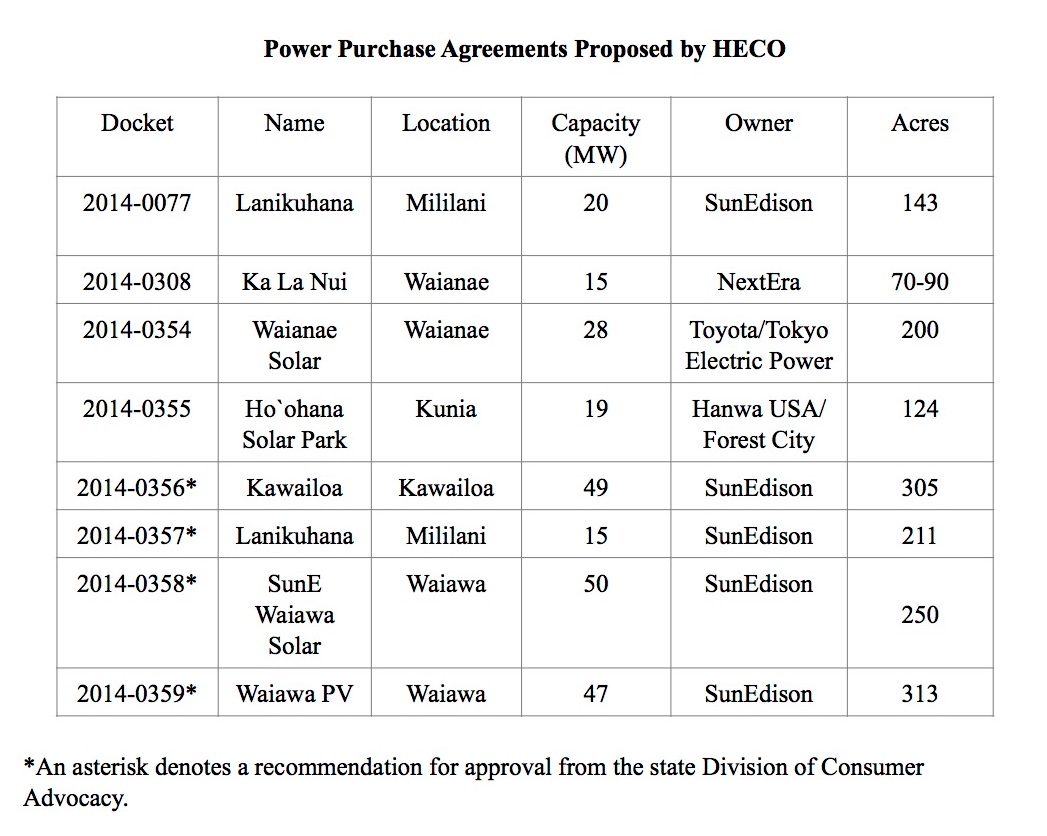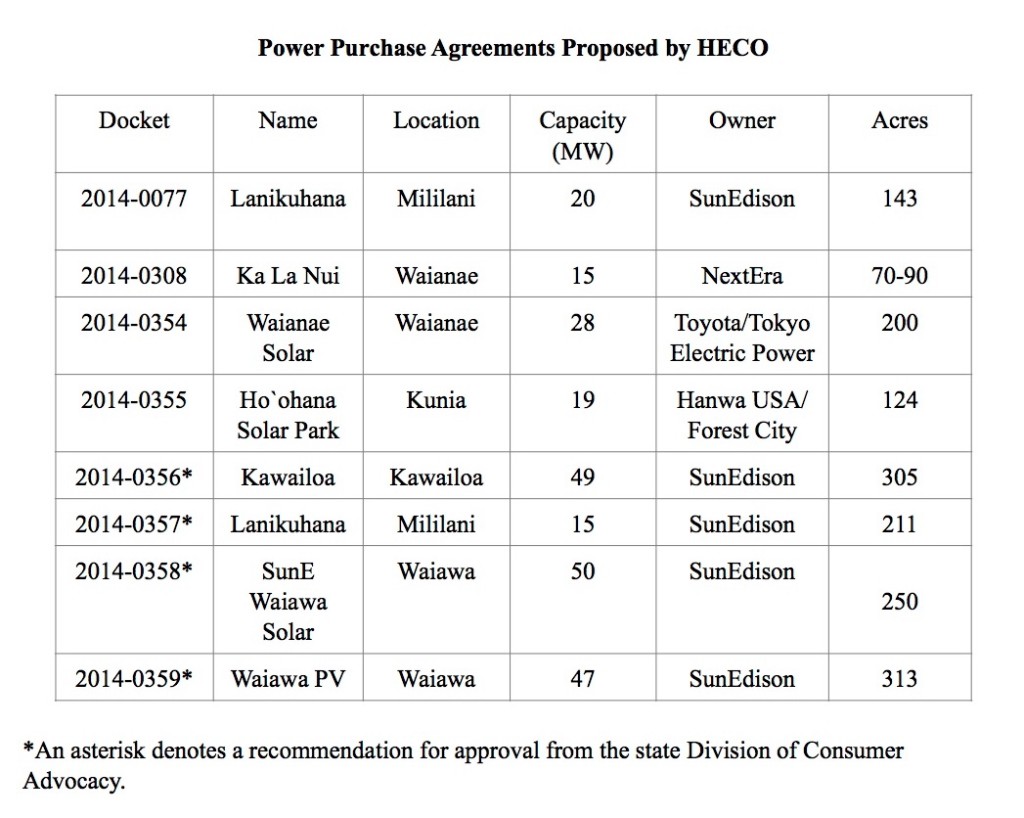It was big news last winter when Hawaiian Electric Company – HECO, the utility that serves O`ahu – announced that it had reached power purchase agreements (PPAs) with developers of six large-scale solar farms that would, when operational, feed more than 200 megawatts of power into the O`ahu grid.
At the time, Shelee Kimura, a HECO vice president, described the agreements as “a significant step toward transforming the generation portfolio on O`ahu to achieve our aggressive, low-cost clean energy goals.”
Those agreements were in addition to two earlier PPAs with a capacity of around 34 megawatts. All totaled, HECO was seeking approval from the Public Utilities Commission of eight PPAs having a combined capacity of 243 megawatts.
Over the next few months, the agreements were reviewed by staff at the Public Utilities Commission and the state Division of Consumer Advocacy.
Then, on June 2, in a move that surprised many – not least HECO – the PUC deferred acting on six of the proposed agreements. In the case of a seventh, given delays in completing an interconnection requirements study, the commission amended the procedural schedule. In each case, the PUC raked the utility over the coals for the scarcity of information and the unsubstantiated arguments it had made in support of the proposals. And the commission did so even as it acknowledged the tight time constraints imposed by the December 31, 2016, deadline for such projects to be operational if the developers are to qualify for a federal investment tax credit of 30 percent.
In addition, the PUC rejected outright an eighth proposal: HECO’s request for approval of a power purchase agreement with a 20 MW solar farm near Mililani.
To push the other dockets further down the road to a final decision, the commission ordered HECO to address the deficiencies in its earlier filings by June 12. After that, HECO, the consumer advocate, and commission staff would participate in a “technical conference” to give HECO the opportunity to “quickly clarify any remaining questions.”
‘Time Is of the Essence’
In the meantime, under the agreements that HECO has with the developers, a critical milestone has passed. All of them contain what the PUC has termed “drop-dead dates” – clauses that give the developers the option to pull out within certain time frames if PUC approval is not obtained by certain dates.
In the case of Waianae Solar, for example, the agreement with HECO states that it is of critical importance that the PUC make a decision on the agreement “as expeditiously as possible, but no later than June 15, 2015.” Similar provisions, with varying deadlines, are in all of the other PPAs as well.
Lanikuhana Solar’s PPA for a 15 megawatt (MW) plant in Mililani quotes from a statement by the developer that, “We do not believe that the project … can be successfully developed without a financial close in July 2015. Commission approval of the PPA for the project would need to be received by May 4, 2015, in order for any appeal period to pass in time to allow financial closing to occur in July 2015.” The PPA allows the developer 90 days from May 4 to “declare the PPA null and void if Commission approval is not obtained by such date.” Identical language appears in the PPA for the 47 MW Waipio facility.
Waiver Projects
All of the proposals for the utility-scale solar plants are so-called waiver projects. Nine years ago, the PUC set forth a framework for utilities to add capacity to their grids from independent power producers through a competitive bidding process. At the urging of Hawaiian Electric, certain exemptions – or waivers – from the competitive bidding framework were granted, including an exemption for developments with a capacity of 5 MW or less and for “power from a non-fossil fuel facility … that is being installed to meet a governmental objective.”
In February 2013, in an effort to push toward the sustainable-energy goals in the state’s Renewable Energy Portfolio, HECO invited proposals from developers that could bring their projects online before the end of 2015 and do so within terms of a model power purchase agreement “without substantial modification.” Also, the projects had to be greater than 5 MW capacity, with electricity priced at less than 17 cents per kilowatt hour (kWh). Proposals that met these terms would be submitted by HECO to the PUC for approval as so-called waiver projects.
Twenty-six companies responded to the proposal by the deadline of March 22, 2013. One application was rejected because it was submitted late. Thirteen were above the target price. One was eliminated because HECO determined the developer did not have control of the project site. One was rejected because it was proposed on an island other than O`ahu.
The 10 remaining proposals were winnowed down further to six after four refused to revise their pricing when the Legislature did not pass an anticipated state tax credit. Then the utility kicked off the highest-priced offer, leaving five on the table, all of which had kWh costs hovering in the range of 16 cents. Four were for solar farms, one was for a wind farm. By November, however, two of the projects, including the wind farm, had dropped out.
In September and October 2014, two of the last three dropped out as well, leaving just one: NextEra’s proposed 15 MW Waianae plant, which was the subject of HECO’s application for approval of a power purchase agreement submitted on October 10, 2014.
In the meantime, HECO had issued a “refresh opportunity” to 20 developers that did not make the cut in the first round, inviting them to submit proposals with a the target price of 16.25 cents per kWh or less. Six survived the winnowing process this time and were the subject of the applications submitted to the PUC on December 4, 2014.
* * *
The Corporate Sponsors
Of the two dozen or so projects that were proposed in response to Hawaiian Electric’s first invitation to renewable energy developers, just one, for Ka La Nui Solar, made it through to the point where a completed power purchase agreement was submitted to the Public Utilities Commission.
And that one is with a subsidiary of NextEra, the corporation that is poised to take over all three Hawaiian Electric utilities should the takeover be approved by the PUC.
Five of the eight power purchase agreements are with SunEdison. The 167 MW of power that SunEdison facilities would provide – were all to win PUC approval – account for nearly three quarters of the total solar capacity HECO is proposing in these applications. If the Lanikuhana facility for 20 MW is excluded (as the PUC has already done), SunEdison facilities will still be generating more than 72 percent of the power put out by the solar farms.
To be sure, SunEdison did not start out owning all these projects. The two Mililani projects were owned originally by Lanikuhana Solar, LLC, a subsidiary of Castle & Cooke Homes Hawai`i. In 2013, Castle & Cooke sold the company to First Wind of Boston, which operates two wind farms on Maui as well as two on O`ahu’s North Shore. Last January, First Wind was acquired by SunEdison.
First Wind also was the developer of Kawailoa Solar, to be built adjacent to its wind farm there and designed to share its transmission facilities, and of the 47 MW facility proposed for Waiawa.
The only project that SunEdison was developing from the start is the other project at Waiawa, for 50 MW.
HECO itself had proposed a 15 MW project to be developed alongside the utility’s 650 MW Kahe power plant. Last November, the PUC rejected the proposal, finding that HECO had not shown that this would reduce energy costs to customers.
— Patricia Tummons
Volume 25, Number 2 August 2015



Leave a Reply